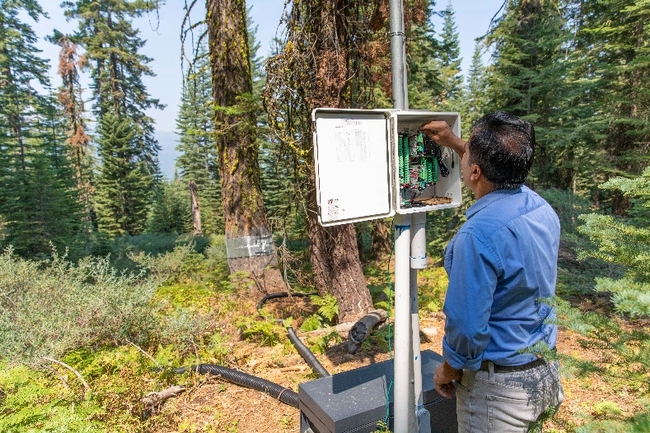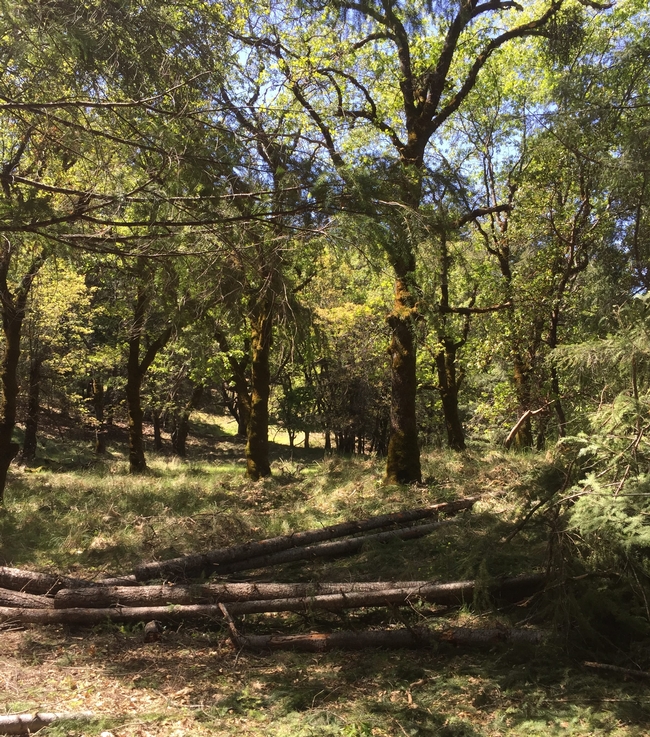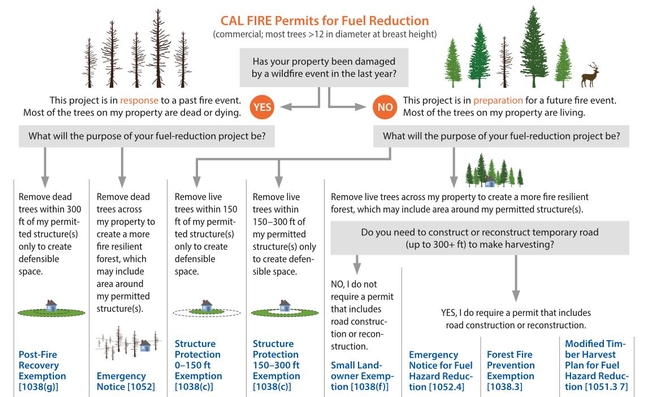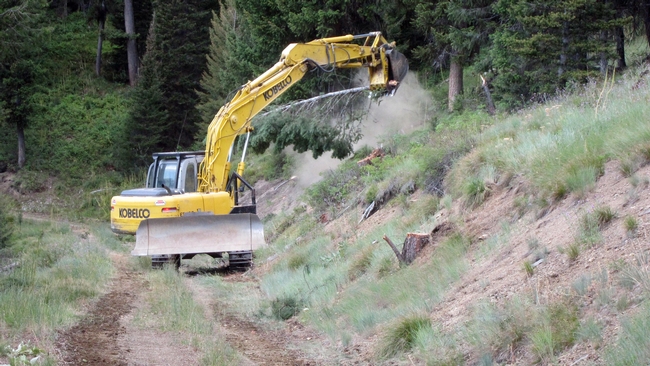
Posts Tagged: fuel
French Meadows partnership completes fourth season of work
Safeeq Khan of UC ANR among collaborators on forest treatments in the Sierra
Despite the challenges of an extremely dangerous fire season, including California's largest wildfire in 2022 (Mosquito Fire) impeding access and limiting operations, partners of the French Meadows Forest Restoration Project have wrapped up their fourth season of forest treatments in the critical headwaters of Tahoe National Forest. Safeeq Khan, Cooperative Extension specialist in water and watershed sciences with UC Agriculture and Natural Resources, is among the collaborators.
This season, project partners safely treated over 700 acres of federal land using a combination of mastication, mechanical thinning, hand thinning and prescribed fire. On adjacent private land, the American River Conservancy independently raised funds and treated 338 acres. Combined, this all-lands collaborative watershed management project has treated over 6,000 acres in just four seasons.
Work this season focused on areas most prone to wildfire ignition. The United States Forest Service treated over 200 acres with prescribed pile burns in and around the Talbot campground, improving the aesthetic quality of this important recreation area just north of French Meadows Reservoir. Although dry conditions limited the scope of prescribed burns this year, using fire as a management tool is a cost-effective way to maintain forest conditions that contribute to ecosystem resilience and human health and safety.
“Prescribed burns are a critical component of the partnership's ecological forestry model,” explained Edward Smith, forest ecologist and fuels manager with The Nature Conservancy. “Under ‘prescribed conditions' of wind, moisture and temperature, broadcast burning helps reduce the amount of tinder on the forest floor as well as fuel ladders that could otherwise carry wildfires into the tops of trees, protecting habitat for humans and diverse wildlife species. Fire also reduces brush and twigs to ashes that feeds the roots of trees and understory plants, protecting the soil and its microbial universe, making them more resilient to drought, insects and climate change.”
Mechanical thinning, hand thinning, and mastication operations continued in areas surrounding water research instrumentation, installed by the Sierra Nevada Research Institute at the University of California, Merced. Over the coming years, researchers will be assessing how vegetation changes in ecologically-based forest management affect water quantity in the local watershed.
“Optimal restoration of forested headwaters benefits from dedicated partnerships collecting scientific data,” said Khan, who is also an adjunct professor of civil and environmental engineering at UC Merced. “UC Merced is working to provide this dimension at French Meadows with strategic measurements and modeling.”
Perhaps the partnership's biggest success in 2022 was securing, via multiple grants, the remaining funding necessary to complete all the thinning operations defined in the original project plan. Since the project's inception more than six years ago, the partnership has operated under an innovative funding arrangement consisting of local, state and federal dollars combined with private donations.
“What has impressed me most about the French Meadows partnership is its commitment to see the project all the way through: start to finish,” said Tahoe National Forest Supervisor Eli Ilano. “With the new funding secured this year, we will be able to wrap up thinning operations, and turn our focus to managing and maintaining the land for the enjoyment of the public.”
American River District Ranger Mary Grim with the U.S. Forest Service added, “This partnership learns from each year to adaptively manage for resilient forests that benefit everyone. The French Meadows Project is a reminder of what can be accomplished with a shared sense of stewardship for our forests and natural resources.”
Fuels reduction work this season resulted in more than 1.066 million board feet of overstocked timber, which was brought to a local mill, with the revenue generated offsetting some of the restoration costs. Project partners also repaired over seven miles of roadway and culverts to reduce sedimentation.
“Under the threat of a second consecutive severe fire season, including the Mosquito Fire in our own ‘backyard,' the partnership diligently moved treatment activities forward and began discussions on how to sustain the project's benefits through long-term maintenance planning,” said Kerri Timmer, regional forest health coordinator with Placer County, who coordinates the stewardship agreement with the Tahoe National Forest.
The catalyst of the French Meadows Forest Restoration Project was the 2014 King Fire, which burned over 97,000 acres in the American River watershed, much of it at high intensity. Eager to reduce the risk to hydroelectric assets, water quality, and biodiversity from future high severity wildfires, Placer County Water Agency joined with Placer County, The Nature Conservancy, the United States Forest Service, American River Conservancy, Sierra Nevada Conservancy, and the Sierra Nevada Research Institute at the UC Merced, to form the French Meadows Partnership.
The project spans more than 22,000 acres of federal land, nearly 7,000 acres of private land, and is a test case for the partnership's effectiveness in improving fire resilience and the overall health of the watershed.
To learn more about the French Meadows Forest Restoration Project, visit and tour the Project's story map.
Free wildfire publication simplifies understanding fuel-reduction permits on private land
UCCE forest advisor helps landowners, community groups determine best project options
As Californians prepare for another year of drought and an anticipated intense fire season, landowners and organizations across California have been working to reduce forest fuels – flammable woody material – that can endanger their properties and communities.
For many of them, however, their urgent efforts hit a sizable speed bump: a massive rulebook that describes, amid a thicket of other information, the permits required before people can treat or remove fuels – as well as a litany of attached requirements, restrictions and stipulations.
“The California Forest Practice Rules are 410 pages, in font size 6,” said Yana Valachovic, UC Cooperative Extension forest advisor for Humboldt and Del Norte counties and registered professional forester. “Trying to figure out what permit vehicles make sense in the rulebook is not easy even for the experienced professional forester.”
To assist private landowners and community groups in deciphering the rules and determining their most cost-effective options, Valachovic took the lead in writing a new guide, “Planning and Permitting Forest Fuel-Reduction Projects on Private Lands in California,” available as a free resource in the UC Agriculture and Natural Resources catalog.
“We tried to create a system where all the permits are laid out side-by-side, and put in a decision tree framework to help make it easier,” said Valachovic, highlighting the publication's tables that break down the project goals and parameters a permit applicant should think about when weighing their choices.
Considerations include whether the project is pre- or post-wildfire, the location and dimensions of trees targeted for removal, the conditions of the site before and after the project, potential time limits, commercial options, and, crucially, budget constraints – given that the permitting process could comprise up to one-third of total project costs.
A primer for planning and preparation
Chris Curtis, the unit forester for CAL FIRE's Humboldt-Del Norte Unit, said that he and his colleagues are grateful for this new tool and plan to use it as an “over the counter” handout for community members. He added that the charts summarizing timber-harvesting regulations and possible funding sources are especially helpful.
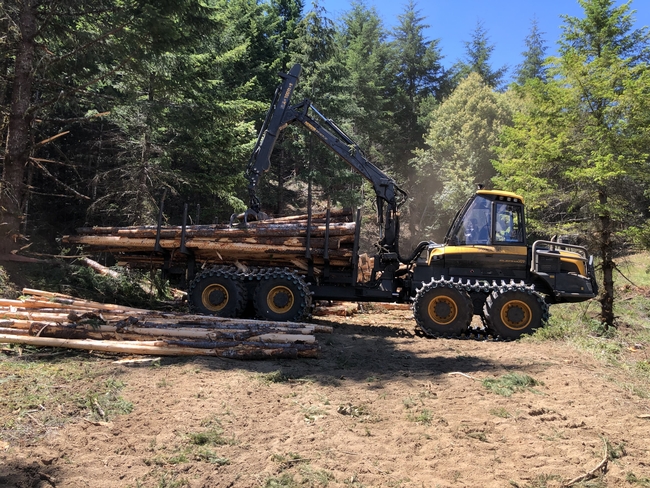
The publication helps prepare the landowner or community entity (such as Resource Conservation Districts, Fire Safe Councils or other concerned groups) for the types of questions that might come up in preliminary planning conversations with a registered professional forester or RPF.
Just as a homeowner would talk with a contractor before tackling a construction project, landowners and community groups must consult with an RPF, Valachovic said. RPFs have the specialized knowledge of forest practice rules and regulations related to water, air quality and endangered species protections, and the license to file the permitting documents.
“That's what I do in my job: Landowners come to me and we start talking about goals and objectives,” she said. “We start thinking about potential timelines – which goals are short-term, which are long-term – and how we can put an operational plan together to help those landowners achieve their goals.”
Long-term projects, short-term actions
Among the many practical tips outlined in this guide, Valachovic emphasized one in particular: for landowners dipping their toes into fuel reduction for the first time, keep the project “simple and realistic.”
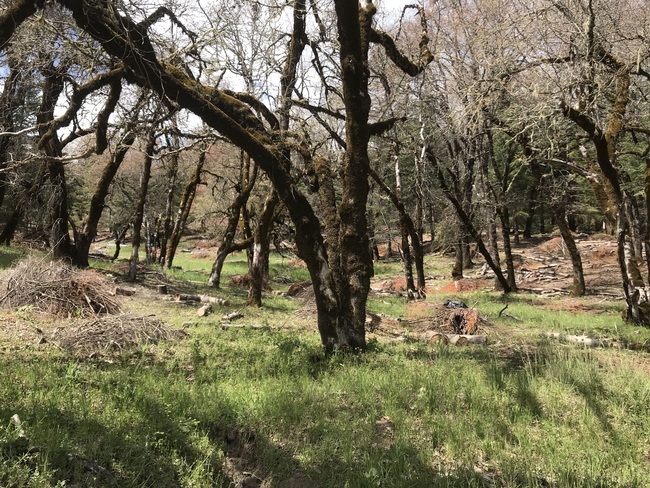
In the short-term, however, Valachovic stressed that the extremely dry conditions across the state make it imperative for Californians to harden their homes, manage the fuels (i.e., landscape plants, stored wood, tall grass, etc.) immediately adjacent to their homes, and devise and review family emergency plans; see UC ANR's Wildfire Preparation page for detailed information and resources.
“There are a lot of immediate actions that people can be doing this year to help mitigate their wildfire risks and prepare for the unexpected,” she said.
In addition to Valachovic, co-authors of “Planning and Permitting Forest Fuel-Reduction Projects on Private Lands in California” are Jared Gerstein of BBW Associates and Brita Goldstein, UCCE staff research associate in Humboldt and Del Norte counties; both are registered professional foresters.
Federal government proposes new fuel breaks to manage wildfire
The Federal Government has proposed spending $55 to $192 million to clear large swaths of land in the Western U.S. to create fuel breaks that slow the spread of wildfire, reported Brady McCombs of the Associated Press. The fuel breaks will be managed by the Bureau of Land Management in Idaho, Oregon, Washington, California, Nevada and Utah.
Fuel breaks are a useful tool if used along with other wildfire prevention methods that can keep firefighters safer and potentially help out in broad scopes of land because they are long and thin, said Lenya Quinn-Davidson, the area fire advisor for University of California Cooperative Extension. They can be especially helpful by providing perimeters for prescribed burns. But they must be in the right places, she said.
The article said the BLM has done about 1,200 assessments of fuel breaks since 2002 and found they help control fires about 80 percent of the time. The new fuel breaks will be 500 feet wide or less and created along highways, rural roads and other areas already disturbed.
Forest fuel breaks lived up to their billing
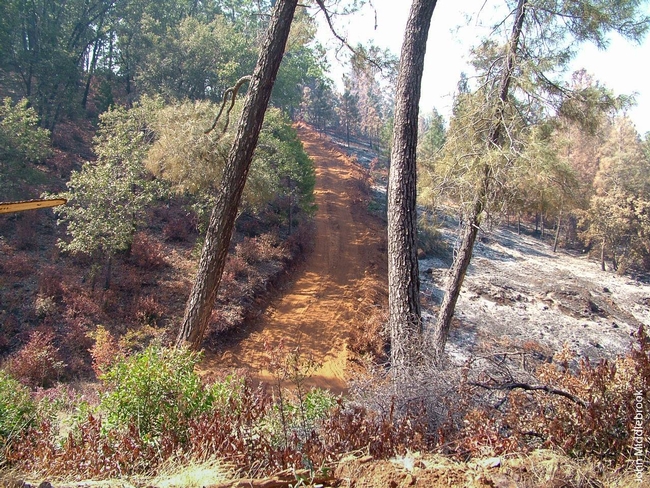
UC ANR Cooperative Extension hosted the tour to bring together the different agencies that can collaborate fighting fires, managing forests and building and maintaining fuel breaks to arrest the spread of wildfire.
"Part of the reason (Old Station) didn't burn down is because of all the fuel breaks that the Forest Service had implemented around that general area," said UC ANR Cooperative Extension forestry advisor Ryan DeSantis. "The majority of fires we see are impeded by fuel breaks. They give firefighters time and safer places to fight fires."
Tour participants also discussed maintenance of current fuel breaks, both with and without herbicides. One issue is lack of funding.
"It's good to have everyone come to the table, all the different organizations all the different agencies and get together to discuss what the issues are and how to get through them," DeSantis said.
New Plant Protein Discoveries Could Ease Global Food and Fuel Demands - UC San Diego

Click here to read the full article from UC San Diego>>

